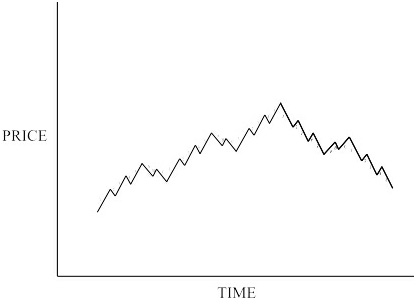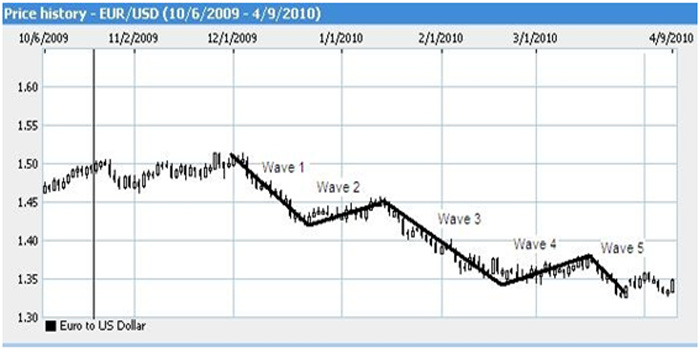Module 9 – Elliott Waves and Cycles of Time
Introduction
Elliott Wave Theory has been around for decades. Ralph Nelson Elliott first used it in the 1930s, but it wasn’t until the 1970s that it was popularized in the book ‘Elliott Wave Principle’ which was written by Prechter and Frost. It builds directly onto the Dow Theory — in fact Elliott said that his Wave Principle was ‘a much-needed complement to the Dow Theory’. Because Dow referred to the motion of the sea when he described price movements, Elliott chose to call his price movements ‘waves’.
The Basics of Waves
The basics of the theory are very simple. In its fundamental form, Elliott simply said that stock market prices follow a repetitive pattern of a five wave advance followed by a three wave decline. ‘Wave’ in this context is any single price move up or down, so the most basic diagram of the Elliott Wave Theory looks like this –

The five wave advance is numbered 1 to 5, and the three wave decline is lettered A, B, and C. Waves 1, 3, and 5 are in the trend direction, and are called impulsive waves, and the correction waves 2 and 4 in the uptrend are called corrective waves. In the downtrend, waves A and C are in the direction of the trend and are the impulsive waves, and B is the corrective wave.
Elliott didn’t say that there was only this form, the five wave pattern, but that was asserted by Frost and Prechter and has become generally accepted. So the primary assumption of the Elliott Wave Theory is that each movement of the price trend has five components, waves 1 to 5, followed by a three wave correction.
Of course, if the theory stopped there, it would be so simple that it might not have received such a great following as it has today. The crucial next step is to say that this pattern is scalable, or you might know the term multifractal if you have read about the modern Chaos Theory. Each of the basic waves can be subdivided into waves of a lesser degree, meaning that waves 1 and 2 are made up of five smaller waves and three smaller waves respectively. If you break all the original waves down in this way, this is what you get –

Each of these waves can also be broken down again to make much smaller waves, or on the other hand the original pattern is just two waves of a larger Elliott Wave pattern. You can scale up and down, and Elliott gave names to each of these patterns sizes. They range from the Grand Supercycle, which might encompass 100 years or more, through Supercycle, Cycle, Primary, Intermediate, Minor, Minute, Minuet, right down to the Subminuette category, which may last a few minutes. It’s not necessary to know these names, and you will probably only deal with the Intermediate and Minor classifications in your trading.
There are some basic rules of the Elliott Wave structure, and they include —
- A correction never takes five waves — if you see five waves it’s probably just the first wave of a larger three wave decline. It might otherwise warn of a change in trend.
- A cycle is not complete until both the five wave and three wave patterns are traced out.
- You measure a wave by its size on the chart, not by time.
- Wave 3 in a five wave move is usually the longest, and never the shortest.
- Of the three waves 1, 3, and 5, the impulsive waves, two will tend to be equal in length, and these would usually be 1 and 5, but not always.
- The other two waves, 2 and 4, would also tend to be the same length as each other.
- The bottom of wave 4 must never go below the bottom of wave 2; otherwise your interpretation is incorrect.
- Often wave 1 and 4 will be equal; also waves 2 and 5.
- For the corrective move, usually waves A and C will tend to be equal.
The three wave correction will typically retrace about one third of the five wave sequence; often the correction will stop at the bottom of wave 4.
There are a lot of guidelines for a simple concept, but they are intended to help you properly identify the stages of the wave pattern. As an example, here’s the chart for the Euro against the US dollar with five waves marked on it. Wave 3 is definitely the longest, and waves 1 and 4 are approximately equal. You can see A and B of the correction have already been traced out by the price.



Join the discussion